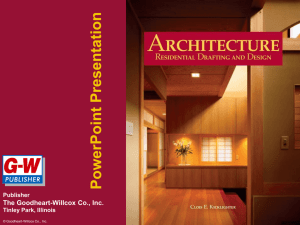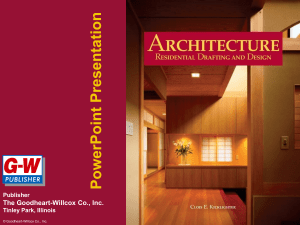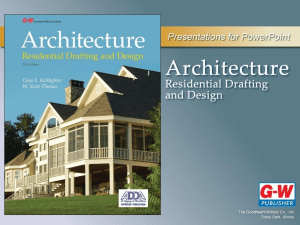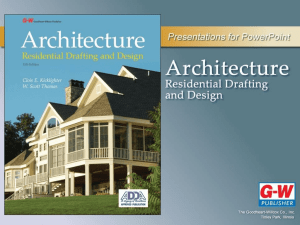Arch10 chapter 10
advertisement
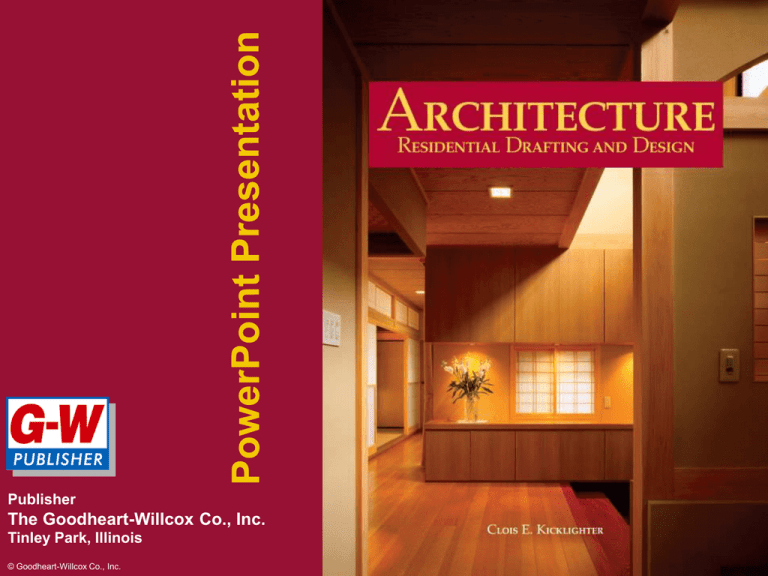
Publisher The Goodheart-Willcox Co., Inc. Tinley Park, Illinois © Goodheart-Willcox Co., Inc. 1 Permission granted to reproduce for educational use only Chapter 15 Plot Plans 2 © Goodheart-Willcox Co., Inc. Permission granted to reproduce for educational use only Introduction to Plot Plans • A site plan is a (top) view drawing that shows the contours of the building site and location and orientation of any buildings on the property. • The plot plan shows both the property and the proposed new construction. 3 © Goodheart-Willcox Co., Inc. Permission granted to reproduce for educational use only The Site Plan • The purpose of a site plan is to show the property lines and the existing topography of the site. – – – – – – Length and bearing of each property line Contour of the land Meridian arrow Existing streets, driveways, sidewalks and patios. Lot number or address of the site Scale of the drawing 4 © Goodheart-Willcox Co., Inc. Permission granted to reproduce for educational use only Typical Site Plan 5 © Goodheart-Willcox Co., Inc. Permission granted to reproduce for educational use only Plot Plan Features • Plot plans contain: – Length and bearing (direction) of each property line. – Location, outline, and size of buildings on the site. – Contour of the land. – Elevation of property corners and contour lines. – Meridian arrow (north symbol). 6 © Goodheart-Willcox Co., Inc. Permission granted to reproduce for educational use only Plot Plan Features • Plot plans also show: – Trees, shrubs, streams, and gardens. – Streets, driveways, sidewalks, and patios. – Location of utilities. – Easements for utilities and drainage. – Well, septic tank, and leach field. – Fences and retaining walls. – Lot number or address of the site. – Scale of the drawing. 7 © Goodheart-Willcox Co., Inc. Permission granted to reproduce for educational use only Property Lines • Property lines define the site boundaries. • Length and bearing of each line are identified. • Measured to 1/100 foot. • A benchmark is shown with a symbol and represents a point of reference. • The order of drawing property lines is clockwise. 8 © Goodheart-Willcox Co., Inc. Permission granted to reproduce for educational use only Property Line Designation • This property line is 175.25' long and has a bearing of N 89° E. 9 © Goodheart-Willcox Co., Inc. Permission granted to reproduce for educational use only Bearings 10 © Goodheart-Willcox Co., Inc. Permission granted to reproduce for educational use only Benchmarks 11 © Goodheart-Willcox Co., Inc. Permission granted to reproduce for educational use only Drawing Property Lines 12 © Goodheart-Willcox Co., Inc. Permission granted to reproduce for educational use only Contour Lines • Contour lines help describe the topography of a site by depicting the shape and elevation of the land. • Contour lines connect points that have the same elevation. • Contour interval is the vertical distance between two adjacent contour lines. 13 © Goodheart-Willcox Co., Inc. Permission granted to reproduce for educational use only Contour Terms and Features • Closely spaced contour lines indicate a steep slope. • Contours that are smooth and parallel show that the ground surface is even. • Closed contour lines represent summits and depressions. • Contour lines of different elevations do not cross. 14 © Goodheart-Willcox Co., Inc. Permission granted to reproduce for educational use only Contour Lines • This illustration shows a five foot contour interval. 15 © Goodheart-Willcox Co., Inc. Permission granted to reproduce for educational use only Contour Lines 16 © Goodheart-Willcox Co., Inc. Permission granted to reproduce for educational use only Contour Lines • The relative space of contour lines represents the slope angle. 17 © Goodheart-Willcox Co., Inc. Permission granted to reproduce for educational use only Contour Lines • Contour lines show relative roughness of the land as well as the elevation. 18 © Goodheart-Willcox Co., Inc. Permission granted to reproduce for educational use only Contour Lines • Summits and depressions are represented by closed contour lines. 19 © Goodheart-Willcox Co., Inc. Permission granted to reproduce for educational use only Contour Lines • Show estimated contours with a dashed line. Surveyed contours are represented by solid or long dashed lines. 20 © Goodheart-Willcox Co., Inc. Permission granted to reproduce for educational use only Contour Lines 21 © Goodheart-Willcox Co., Inc. Permission granted to reproduce for educational use only Contour Lines 22 © Goodheart-Willcox Co., Inc. Permission granted to reproduce for educational use only Contour Lines 23 © Goodheart-Willcox Co., Inc. Permission granted to reproduce for educational use only Contour Lines • Contour lines plotted from an elevation grid using data supplied by a surveyor. 24 © Goodheart-Willcox Co., Inc. Permission granted to reproduce for educational use only Topographical Features • Topographical features include: – Trees, shrubs, streams, roads, utilities, fences, and similar features. • These features are represented by symbols; most are standardized. • Nonstandard symbols should appear with an explanation in a legend on the drawing. 25 © Goodheart-Willcox Co., Inc. Permission granted to reproduce for educational use only Topographical Symbols 26 © Goodheart-Willcox Co., Inc. Permission granted to reproduce for educational use only Topographical Symbols • When color is used with topographical symbols, follow these guidelines. – Black is used for lettering and human-built works, such as roads, houses, etc. – Brown represents all land forms such as contour lines. – Blue is used for water features. – Green is for vegetation. 27 © Goodheart-Willcox Co., Inc. Permission granted to reproduce for educational use only Locating the Structure on Site • Analyze the site to determine the ideal location for the structure. • Analysis should include: – Natural contour, trees, view. – Surrounding houses, code restrictions. – Style of house to be built. – Solar orientation, winds. – Placement of well and septic system. – Size and shape of the site. 28 © Goodheart-Willcox Co., Inc. Permission granted to reproduce for educational use only Locating the Structure on Site • Once the location is decided on, the structure can be drawn on the plot plan. • There are three commonly accepted methods of representing a house on the plot plan: – Lay out exterior walls and shade area. – Draw a typical roof plan. – Draw exterior walls thickened. • Dimension the location of the structure on site. 29 © Goodheart-Willcox Co., Inc. Permission granted to reproduce for educational use only Locating the Structure on Site • First method of locating a structure on a plot plan is to lay out the outside of the exterior walls, omitting all interior walls and roof. 30 © Goodheart-Willcox Co., Inc. Permission granted to reproduce for educational use only Locating the Structure on Site • Second method of locating a structure on a plot plan is to draw the exterior walls as hidden lines and show the roof using solid lines. 31 © Goodheart-Willcox Co., Inc. Permission granted to reproduce for educational use only Locating the Structure on Site • Third method of locating a structure on a plot plan is to show the exterior walls thickened. 32 © Goodheart-Willcox Co., Inc. Permission granted to reproduce for educational use only Locating the Structure on Site • The simplest way to highlight a structure is to crosshatch the entire building area or hatch around the perimeter of the structure. The overall representation of the structure should conform to the overall style of the drawing and the other symbols used. • © Goodheart-Willcox Co., Inc. 33 Permission granted to reproduce for educational use only Locating the Structure on Site • The location of the structure on the site must be dimensioned. Dimension the distance from a wall to the property line. 34 © Goodheart-Willcox Co., Inc. Permission granted to reproduce for educational use only The Site Plan 35 © Goodheart-Willcox Co., Inc. Permission granted to reproduce for educational use only
